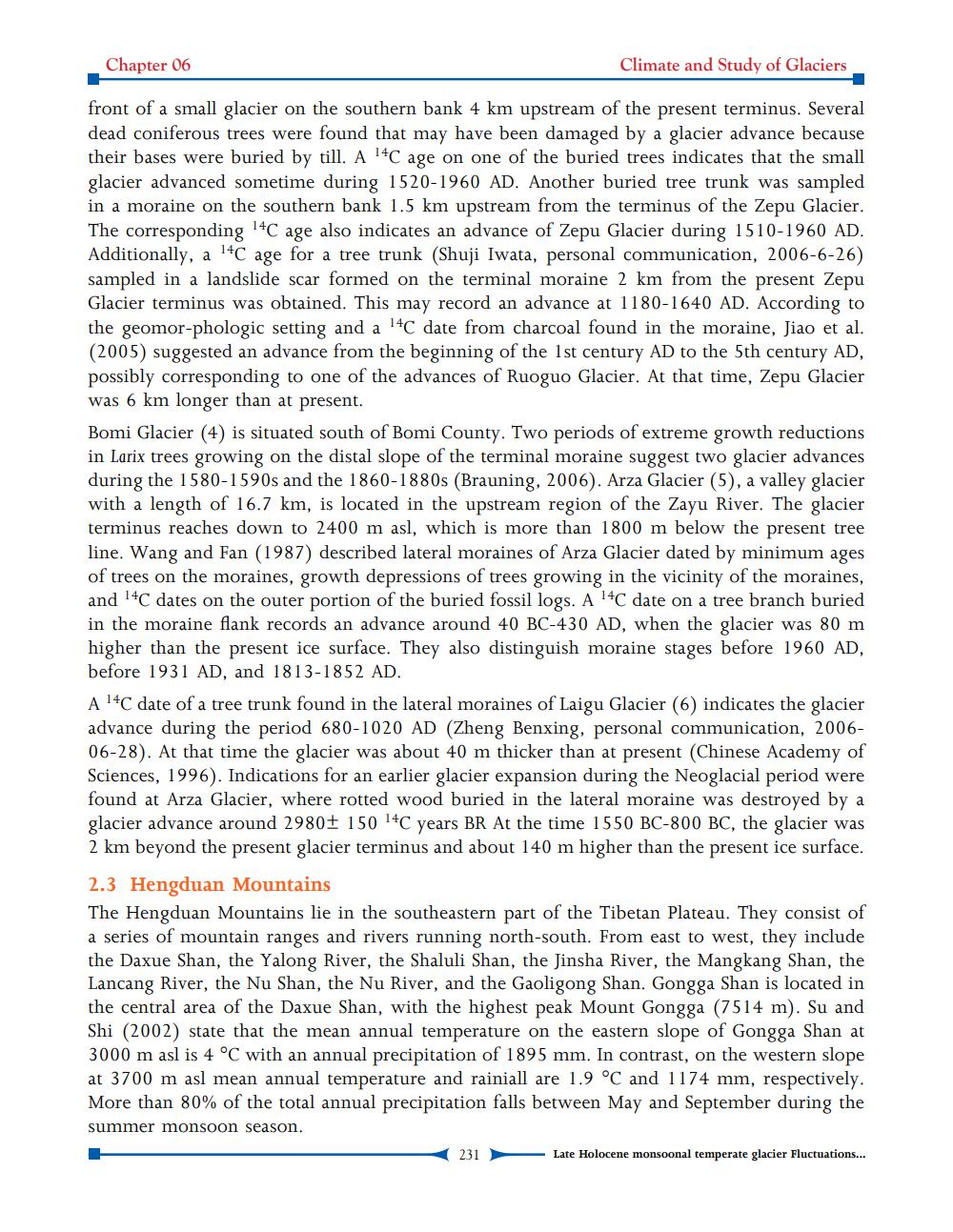________________
Chapter 06
Climate and Study of Glaciers
front of a small glacier on the southern bank 4 km upstream of the present terminus. Several dead coniferous trees were found that may have been damaged by a glacier advance because their bases were buried by till. A 4C age on one of the buried trees indicates that the small glacier advanced sometime during 1520-1960 AD. Another buried tree trunk was sampled in a moraine on the southern bank 1.5 km upstream from the terminus of the Zepu Glacier. The corresponding 14C age also indicates an advance of Zepu Glacier during 1510-1960 AD, Additionally, a 14C age for a tree trunk (Shuji Iwata, personal communication, 2006-6-26) sampled in a landslide scar formed on the terminal moraine 2 km from the present Zepu Glacier terminus was obtained. This may record an advance at 1180-1640 AD. According to the geomor-phologic setting and a 14C date from charcoal found in the moraine, Jiao et al. (2005) suggested an advance from the beginning of the 1st century AD to the 5th century AD, possibly corresponding to one of the advances of Ruoguo Glacier. At that time, Zepu Glacier was 6 km longer than at present. Bomi Glacier (4) is situated south of Bomi County. Two periods of extreme growth reductions in Larix trees growing on the distal slope of the terminal moraine suggest two glacier advances during the 1580-1590s and the 1860-1880s (Brauning, 2006). Arza Glacier (5), a valley glacier with a length of 16.7 km, is located in the upstream region of the Zayu River. The glacier terminus reaches down to 2400 m asl, which is more than 1800 m below the present tree line. Wang and Fan (1987) described lateral moraines of Arza Glacier dated by minimum ages of trees on the moraines, growth depressions of trees growing in the vicinity of the moraines, and 4C dates on the outer portion of the buried fossil logs. A 4C date on a tree branch buried in the moraine flank records an advance around 40 BC-430 AD, when the glacier was 80 m higher than the present ice surface. They also distinguish moraine stages before 1960 AD, before 1931 AD, and 1813-1852 AD. A 14C date of a tree trunk found in the lateral moraines of Laigu Glacier (6) indicates the glacier advance during the period 680-1020 AD (Zheng Benxing, personal communication, 200606-28). At that time the glacier was about 40 m thicker than at present (Chinese Academy of Sciences, 1996). Indications for an earlier glacier expansion during the Neoglacial period were found at Arza Glacier, where rotted wood buried in the lateral moraine was destroyed by a glacier advance around 2980+ 150 14 years BR At the time 1550 BC-800 BC, the glacier was 2 km beyond the present glacier terminus and about 140 m higher than the present ice surface. 2.3 Hengduan Mountains The Hengduan Mountains lie in the southeastern part of the Tibetan Plateau. They consist of a series of mountain ranges and rivers running north-south. From east to west, they include the Daxue Shan, the Yalong River, the Shaluli Shan, the Jinsha River, the Mangkang Shan, the Lancang River, the Nu Shan, the Nu River, and the Gaoligong Shan. Gongga Shan is located in the central area of the Daxue Shan, with the highest peak Mount Gongga (7514 m). Su and Shi (2002) state that the mean annual temperature on the eastern slope of Gongga Shan at 3000 m asl is 4 °C with an annual precipitation of 1895 mm. In contrast, on the western slope at 3700 m asl mean annual temperature and rainiall are 1.9 °C and 1174 mm, respectively. More than 80% of the total annual precipitation falls between May and September during the summer monsoon season.
231
Late Holocene monsoonal temperate glacier Fluctuations...




